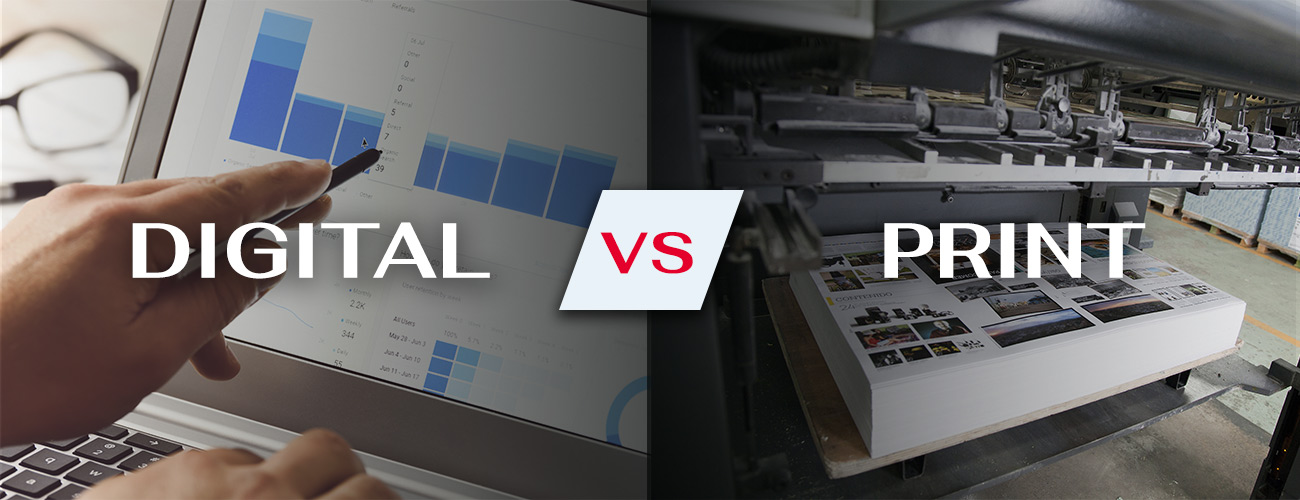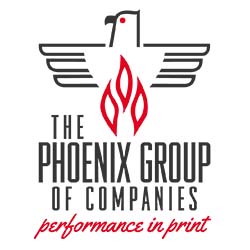Digital vs. Print Marketing: Which is the Most Sustainable?

When it comes time to plan your company’s marketing budget, do you automatically allocate more funds to digital marketing than traditional print marketing? If you do, you’re not the only company placing a greater emphasis on digital marketing. Since the rise of digital marketing and communications, companies have been allocating less and less of their marketing spend on traditional print marketing. Why?
What can be implied by this is that many marketers now view digital marketing as the environmentally friendly choice, while print marketing and communications are often viewed as less environmentally sustainable option. To make responsible choices with your marketing budget, it’s important to understand that this issue isn’t black-and-white. Digital and print both have a positive and negative impact on the environment.
Let’s look at the environmental impact of both types of marketing and discuss why you may want to reconsider print’s role in your company’s marketing mix.
Print Isn’t Dead—Or the Enemy
Today, there are plenty of eco-friendly options for paper stocks, recycled alternatives, and even Forest Stewardship Council-Certified (FSC) papers made from responsibly sourced wood fiber. With so many earth-friendly paper options to choose from, there’s little reason to opt for the non-sustainable alternative. Responsible forestry practices, such as those promoted by the FSC, can even reduce carbon emissions while protecting vulnerable forests and improving air quality. Remember, trees are a renewable resource. Give readers statistics about what the paper industry is doing and something they relate to. The paper industry plants 2.5 billion trees per year. For the more than 20 years they have actually planted more tree than they harvested. As a result the number of acres covered by forests has increased 4.5%.
Beyond raw materials like paper stocks, it’s also important to consider production practices and finishing techniques, as these also play a role in the impact of print marketing on the environment. If your project requires the added protection or enhanced appearance of a UV coating, choose a printer that uses LED UV curing instead of conventional UV curing. LED UV consumes only a fraction of the energy needed for conventional UV coatings.
With the advent of renewable energy certificates (RECs), also known as renewable energy credits, it’s now possible to print with wind-generated electricity and make a significant reduction in the carbon footprint of your next print project.
Using RECs allows you to specify that your project be printed with renewable energy. Based on the amount of energy needed to produce your desired project, print providers like the Phoenix Group will purchase RECs from an energy supplier for you.
The Environmental Impact of Digital Marketing
Global issues like paper use and single-use plastics are well-known and often publicized, but what there’s less awareness around is the issue of e-waste, or the number of old devices being regularly discarded around the world. This year alone, it’s estimated that we will generate approximately 57.4 million metric tons of e-waste worldwide.
The internet has undoubtedly revolutionized how we work and access information, but it’s often too easy to overlook the technology, infrastructure, and energy constantly operating and being used in the background every time we access the internet. Networked broadband, servers, data centers, cellular towers, and more run continuously to provide us with 24/7 access to information and communication. All of which have contributed to skyrocketing levels of energy consumption in America, and that’s just one part of the impact. By 2030, experts estimate that U.S. data centers’ energy use will increase up to 974 TWh (terawatt hours).The entire US consumed 3,802 terawatt hours in 2020,therefore its possible that data centers alone will account for 26% of our entire electricity consumption.
To put it all into perspective, the carbon output of sending 65 emails is on par with driving an average-sized car 0.6 of a mile. Given that the average office worker sends 40 emails every day, this is comparable to driving 1.8 miles per week. Suddenly, that email marketing campaign you’ve been considering doesn’t sound so eco-friendly, does it?
A Truly Sustainable Approach: Omni-Channel Marketing
Successful marketers know that an omni-channel approach is necessary to reach audiences at every touchpoint and drive real results. The most effective marketing campaigns combine traditional print with digital marketing to increase awareness, drive website traffic, and deliver the best possible return on marketing investment (ROMI). Marketing campaigns that used direct mail and one or more digital channels experienced a 118% increase in response rates compared to using direct mail only.
How do you find the perfect channel combination? Look to your audience. What channels are they using to engage with brands like yours? Once you determine this, you’ll know where you need to be to reach them. Combining both digital and print tactics for a thoroughly integrated marketing plan will ensure that your company uses its marketing spend to achieve the best possible results. Doing so also allows you to get more creative with your campaigns. Print marketing materials can feature personalized URLs, QR codes, webinar invitations, and more.
Print Sustainably with The Phoenix Group
The fact of the matter is that you can invest your marketing budget into both traditional print and digital marketing. If you’re planning your marketing spend based entirely on what’s supposed to be best for the environment, know that going strictly digital won’t automatically be the greenest option. As far as print providers go, the Phoenix Group is an environmentally friendly choice and has a lot of sustainable options to offer.
Interested in working with the Phoenix Group or learning more about our sustainability practices? Contact us today.
